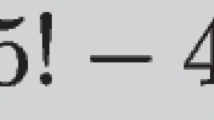Abstract
We construct at least \(\frac{1}{{8n^2 \sqrt 3 }}e^{\pi \sqrt {2n/3} } (1 + o(1))\) pairwise nonequivalent transitive extended perfect codes of length 4n as n → ∞.
Similar content being viewed by others
References
S. A. Malyugin, “On Transitive Perfect Codes of Length 15,” in Proceedings of the Conference on Discrete Analysis and Studies of Operations (Sobolev Inst. Mat., Novosibirsk, 2004), p. 96.
F. I. Solov’eva, “On Construction of Transitive Codes,” Problemy Peredachi Informatsii 41(3), 23–31 (2005).
G. E. Andrews, The Theory of Partitions (Addison-Wesley, London, 1976).
S. V. Avgustinovich, O. Heden, and F. I. Solov’eva, “The Classification of Some Perfect Codes,” Design Codes Cryptogr. 31(3), 313–318 (2004).
K. Phelps, “A General Product Construction for Error Correcting Codes,” SIAM J. Algebraic and Discrete Methods 5(2), 224–228 (1984).
V. A. Zinoviev, “On Generalized Concatenated Codes,” in Topics in Information Theory. Colloq. Math. Soc. J. Bolyai, Ed. by I. Csiszar and P. Elias (North-Holland, Amsterdam, 1977), pp. 587–592.
Author information
Authors and Affiliations
Additional information
Original Russian Text © V.N. Potapov, 2006, published in Diskretnyi Analiz i Issledovanie Operatsii, Ser. 1, 2006, Vol. 13, No. 4, pp. 49–59.
Rights and permissions
About this article
Cite this article
Potapov, V.N. A lower bound for the number of transitive perfect codes. J. Appl. Ind. Math. 1, 373–379 (2007). https://doi.org/10.1134/S199047890703012X
Received:
Issue Date:
DOI: https://doi.org/10.1134/S199047890703012X




